Pavement Markings
Pavement markings help direct drivers and warn them about upcoming road and traffic conditions. They help answer questions such as:
- Which lane can I use?
- Can I pass another vehicle here?
- Is this road one-way only?
Let's look at some pavement markings you may encounter on the road.
Two-Way Roadways
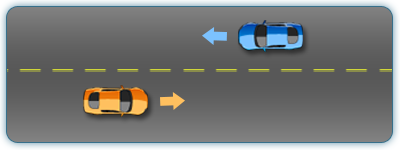
For two-way traffic, a yellow solid or broken line is used to separate two lanes of traffic traveling in opposite directions.
Keep to the right of the yellow center line. You may cross the broken line when passing another vehicle, or when the right half of the roadway is closed to traffic.
Do not cross the line unless it's safe and legal to do so.
One-Way Roadways
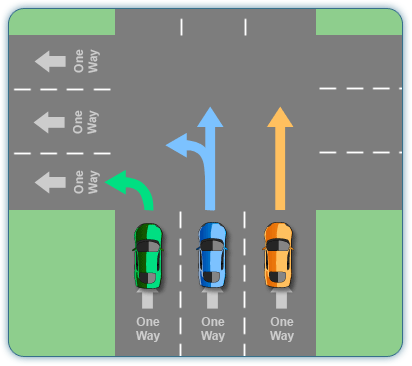
A solid or broken white line is used to distinguish different lanes of traffic flowing in the same direction. On a one-way roadway like the one shown in the above picture,
the broken white line means you may travel in any lane. When you prepare to turn from a one-way road, be sure to move into the correct turning lane well in advance of your turn.
Multi-Lane Highways
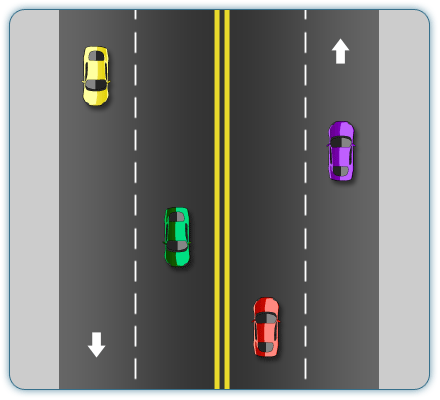
For highways with four or more lanes, double yellow lines are used to distinguish between traffic flowing in opposite directions. In the image above,
you can see how the two lanes on the right are separated from the two lanes on the left by a double solid yellow line. This line lets you know that you cannot cross it in order to pass another vehicle.
Yellow Pavement Markings
Yellow pavement markings are used in a few different ways with different meanings. For example, when you see yellow lines painted parallel along the center of the roadway, it means there is two-way traffic traveling on the road.
Yellow pavement markings include:
- Solid Yellow Lines: Solid yellow lines mean do not cross. A solid yellow line between two lanes of traffic means you may not drive over the line to pass other vehicles.
The only time you may cross over a solid yellow line is to make a left turn at an intersection,
to enter or exit a road or a driveway, or to make a legal U-turn. Only do this when you can complete the action safely and if the action is not prohibited by a sign.
- Broken Yellow Lines: If a single yellow broken line is dividing lanes of traffic (i.e., not a solid, continuous painted line), you are allowed to cross over it to pass other vehicles.
You also may make left turns onto other streets, driveways, and alleys over broken yellow lines as long as it is safe to do so.
- Double Solid Yellow Lines: If the two yellow lines running parallel to each other are both solid, you may not cross over them to pass another vehicle. Think of them as a virtual wall.
These lines are dividing lanes of traffic in a location where it is not safe to cross over. The only times you may cross over a double solid yellow line is to make a left turn at an intersection,
to enter or exit a road or a driveway, or to make a U-turn if there is no sign prohibiting the action and it is safe to do so. Sometimes you will see two sets of double yellow lines two or more feet apart,
dividing lanes of traffic. These represent a wall or center divider.
Do not drive on or over these lines for any reason! If you need to make a U-turn where there are two sets of double yellow lines, you may only do so at an opening provided for turns.
White Pavement Markings
A single or double solid white line between traffic lanes traveling in the same direction may not be crossed for any reason.
While driving on a divided highway, you usually will see a single solid white line used to indicate the rightmost boundary of the drivable roadway. Do not drive to the right of this line.
Sets of solid white lines are used frequently to divide the lanes before an upcoming hazard such as a road obstruction.
This could be before the pillar of an overcrossing, or the median between a freeway off-ramp and normal traffic lanes. These lines also should never be crossed; they exist as a boundary for your safety.
Sometimes white lines are painted thicker and used to separate parts of left and right-turn lanes close to the intersection.
Once the white line becomes thicker, it means you may not cross over the line to enter the turn lane. At this point, you are committed to the lane you are already in.
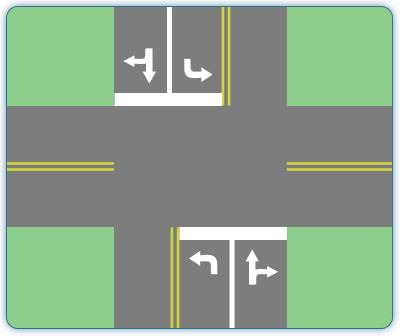
Other white pavement markings include:
- Broken White Lines: If a single broken white line divides lanes of traffic, you may cross over it. Thicker broken white lines tell you that your lane is exiting the roadway,
is merging into other lanes, or the road is ending.
The broken line then merges into a solid white line, or a set of solid white lines that you may not cross.
- White Arrows: White arrows are painted on the roadway in areas where the lane continues straight ahead, merges, turns, or exits.
They help to tell you which lane you should drive in. For example, if you are coming up on an intersection, it helps to have an arrow indicating a right or left turn lane so you know where to position your vehicle.
- White Diamonds: White diamonds indicate an HOV (High Occupancy Vehicle) lane (also known as the carpool lane). They may also indicate a bicycle lane.
Make sure you are allowed to be in this lane before driving in it, or you could receive a fine. HOV lanes are located on some freeways, and they are reserved for cars with two or more occupants.
HOV lanes at freeway on-ramps may be marked with the number of occupants required and the
times of day during which carpooling is enforced.
If you do not have the required number of occupants in your vehicle at the time specified, you may not use the carpool lane.
Other Markings
Here are a few more important pavement markings:
- Stop Lines: Stop lines are indicated by white lines painted across your lane at traffic signs or signals. When these lines are present, you should stop behind the line.
- Edge of Pavement: On the edge of the pavement are painted solid white or yellow lines to indicate the boundary of the drivable roadway. On two-way roads, this boundary line will be painted on the right side of the roadway.
On one-way roads, this boundary line will be painted on both the right and left sides of the roadway. Do not cross this line.
- Obstructions: You will come across pavement markings like this “Do Not Block” sign in front of entities such as fire departments.
Do not block the area that is marked. This is where an ambulance or fire truck will exit when called to an emergency.
- Words and Symbols: You’ll frequently see large white letters and symbols painted on the road to warn you of upcoming signals, stop signs, changes in the lane, bicycle lanes, and crosswalks.
It’s especially important to keep an eye on the roadway’s surface for these words and symbols while you are driving in cities.
Crosswalks
Crosswalks are marked with sets of broad white lines across the road. These are paths of roadway where pedestrians may cross the road. These are reserved for pedestrian traffic.
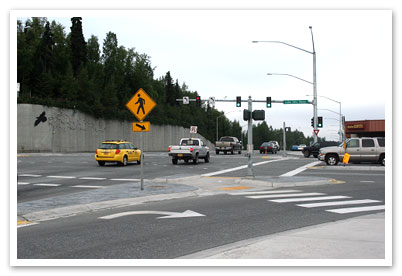
Most intersections have a pedestrian crosswalk, whether or not lines are painted on the street. Most crosswalks are located at corners, but they can also be located in the middle of the block. Before turning a corner,
watch for people about to cross the street on both sides. Pedestrians have the right-of-way in marked or unmarked crosswalks. You may never park in an unmarked crosswalk.
How can you tell if there is an unmarked crosswalk? You can find these at any intersection where the roadways meet at approximately 90-degree angles and there are one or more sidewalks that continue over the roadway.
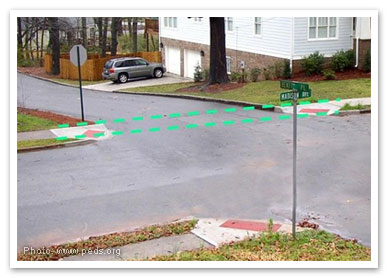
Crosswalks are often preceded by these white words painted on the road: “Slow Ped Xing.”
Keep in mind that pedestrians have the right-of-way at marked and unmarked crosswalks.
School Crossings
Broad yellow lines crossing the road sometimes are used to indicate a school crossing. You should always drive with extreme caution through these areas, because children may be present.
To clearly indicate a school crossing, yellow markings on the pavement saying,
“School Xing,” will usually be painted near the crossing. Always scan the road and sidewalk in all directions for children when you see these markings. They may be waiting to cross the road.
If cars are parked along the side of the road in a school crossing zone, look carefully under the vehicles for little feet. Sometimes children may be waiting to cross from behind a parked car.
Children may not be tall enough for you to see clearly. This is another reason why it is so important to drive slowly through these areas.
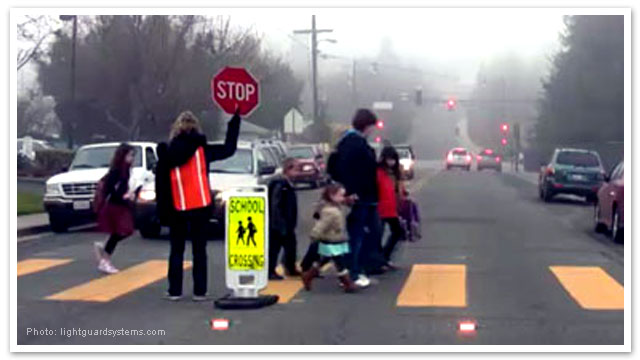
Railroad Crossings
Pavement markings are painted on the roadway in front of railroad crossings to warn you in advance. These include thick white lines across the roadway, a large crosshatch (X), and the letters RR.
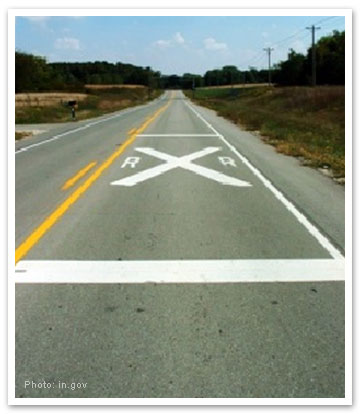
Pavement Markings Video
Check out the following video to learn more about pavement markings.
Take a Course to Learn More
If you enjoyed this article and are interested in learning more about driving-related topics, you should check out our courses on www.safe2drive.com.
We offer courses in a variety of topics including Defensive Driving and Driver Education. In addition to teaching you how to be a safe driver, our courses
can help you dismiss a ticket, get your driver license, or even get an insurance discount. We also have courses specifically tailored to mature drivers (i.e., drivers
age 55 and older) for insurance discounts.